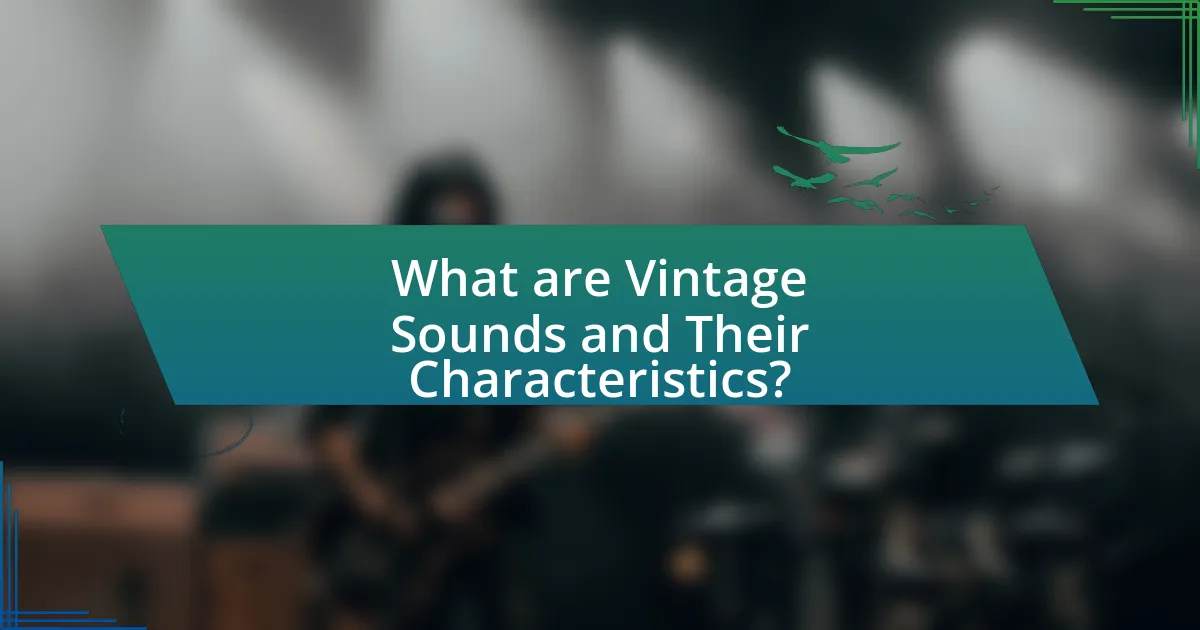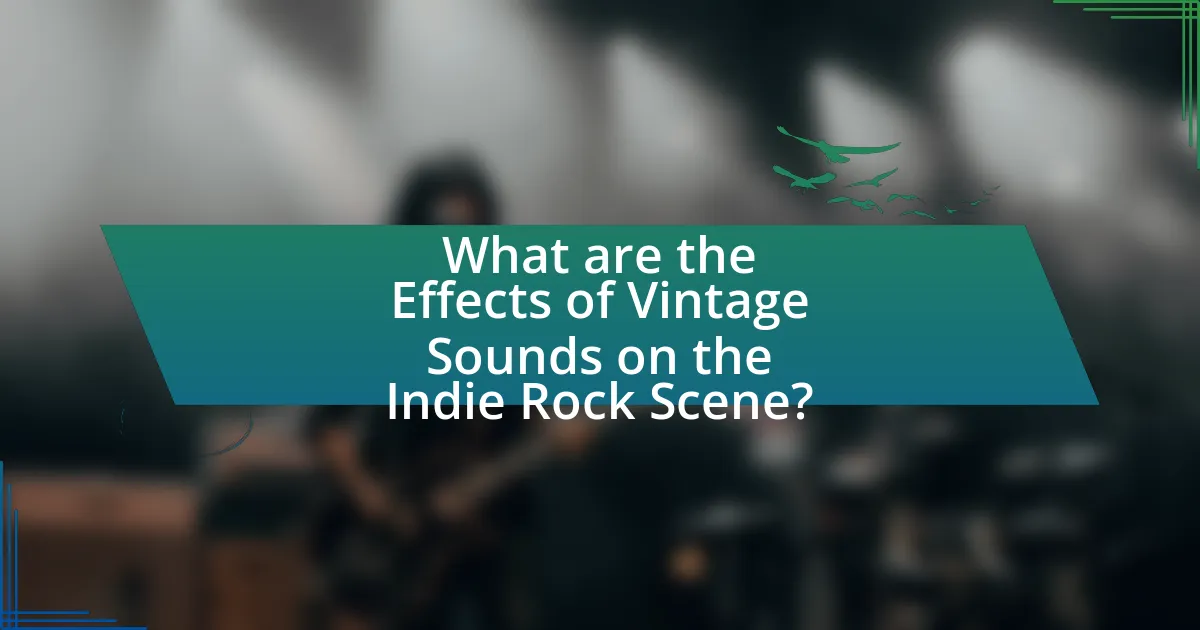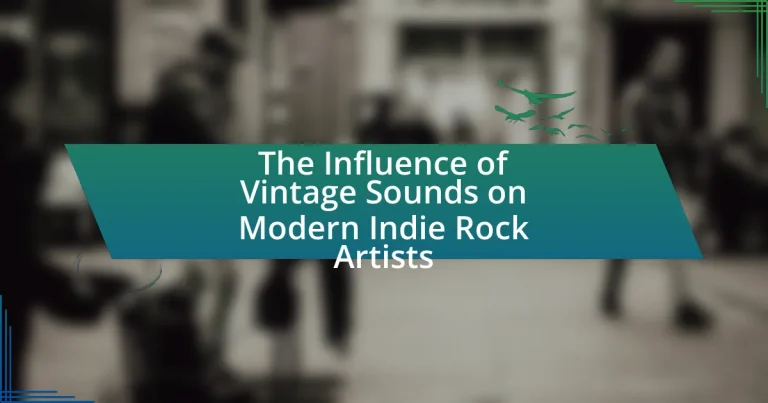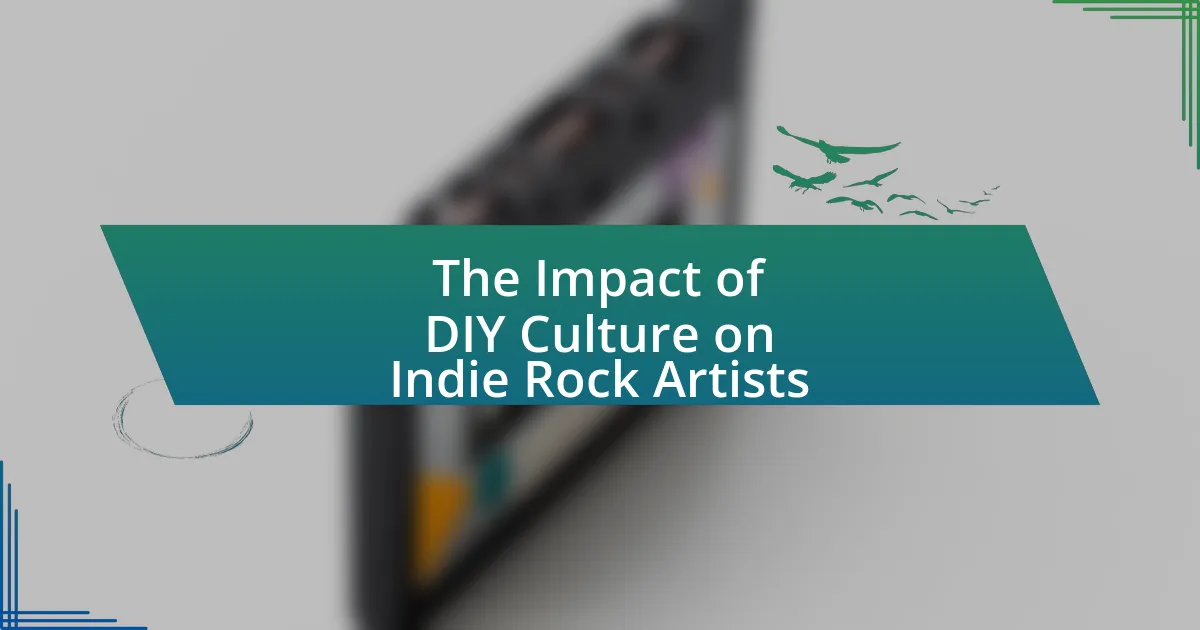The article examines the influence of vintage sounds on modern indie rock artists, highlighting the characteristics and production techniques that define these nostalgic audio qualities. It explores how vintage sounds differ from contemporary music, emphasizing the use of analog recording methods, vintage instruments, and specific production styles that evoke warmth and authenticity. The discussion includes the impact of cultural movements on the perception of vintage sounds, the techniques used by indie rock artists to emulate these qualities, and notable examples of artists who successfully blend vintage influences into their music. Additionally, the article addresses how vintage sounds shape songwriting, themes, and the overall atmosphere of indie rock, providing practical tips for artists looking to incorporate these elements into their work.

What are Vintage Sounds and Their Characteristics?
Vintage sounds refer to audio characteristics and production techniques that evoke a sense of nostalgia, often associated with music from the mid-20th century. These sounds typically feature warm tones, analog recording methods, and imperfections such as tape hiss or vinyl crackle, which contribute to their distinct character. For instance, the use of tube amplifiers and vintage microphones can create a rich, organic sound that is less sterile than modern digital recordings. Additionally, vintage sounds often incorporate specific musical styles, such as rock ‘n’ roll, jazz, or folk, which further define their aesthetic. The resurgence of interest in these sounds among modern indie rock artists highlights their enduring appeal and influence on contemporary music production.
How do Vintage Sounds differ from Modern Sounds?
Vintage sounds differ from modern sounds primarily in their production techniques and tonal characteristics. Vintage sounds often utilize analog equipment, resulting in warmer tones and a natural compression that adds depth, while modern sounds frequently rely on digital technology, leading to cleaner, more polished audio. For instance, the use of tube amplifiers and analog tape in vintage recordings creates a distinct sonic texture that is less prevalent in contemporary music, which often employs digital plugins and software synthesizers for sound design. This difference in technology and approach significantly influences the overall aesthetic and emotional impact of the music produced in each era.
What specific elements define Vintage Sounds?
Vintage sounds are characterized by specific elements such as analog recording techniques, the use of vintage instruments, and distinct production styles that evoke nostalgia. Analog recording techniques, including tape saturation and tube amplification, contribute warmth and depth to the sound, differentiating it from modern digital recordings. The use of vintage instruments, like Fender guitars and vintage drum kits, adds unique tonal qualities that are often sought after by artists aiming for a retro aesthetic. Additionally, production styles that incorporate reverb, delay, and lo-fi effects further enhance the vintage feel, creating a sound reminiscent of the music from the 1960s to the 1980s. These elements collectively define vintage sounds and significantly influence modern indie rock artists who seek to capture that nostalgic essence in their music.
How do production techniques influence the sound quality of Vintage Music?
Production techniques significantly influence the sound quality of vintage music by shaping its tonal characteristics, dynamic range, and overall aesthetic. Techniques such as analog recording, tube amplification, and the use of vintage microphones contribute to a warm, rich sound that is often associated with classic recordings. For instance, the use of analog tape introduces natural compression and harmonic distortion, which enhances the musicality of the recordings. Additionally, the limitations of early recording technology, such as fewer tracks and simpler mixing processes, often resulted in a more organic sound that many modern artists seek to replicate. This is evidenced by the resurgence of interest in vintage recording methods among contemporary indie rock artists, who aim to capture the authenticity and emotional depth characteristic of vintage music.
Why are Vintage Sounds significant in music history?
Vintage sounds are significant in music history because they represent the foundational elements and styles that have shaped contemporary genres, particularly in indie rock. These sounds, characterized by analog recording techniques, vintage instruments, and production styles from the mid-20th century, have influenced modern artists by providing a rich sonic palette that evokes nostalgia and authenticity. For instance, the use of tube amplifiers and vintage microphones in recordings has been shown to create a warmth and depth that digital technology often lacks, as evidenced by the resurgence of vinyl records and analog recording methods in the 21st century. This revival highlights the enduring appeal of vintage aesthetics, which many indie rock artists consciously incorporate into their music to connect with listeners on a deeper emotional level.
What impact did Vintage Sounds have on the evolution of music genres?
Vintage Sounds significantly influenced the evolution of music genres by introducing unique sonic textures and production techniques that shaped the aesthetic of various styles. For instance, the use of analog recording methods and vintage instruments, such as tube amplifiers and classic microphones, created a warm, rich sound that became a hallmark of genres like indie rock, folk, and alternative music. This influence is evident in the works of modern indie rock artists who often emulate the lo-fi production quality and nostalgic elements characteristic of Vintage Sounds, as seen in albums by bands like The Lumineers and Fleet Foxes. These artists draw inspiration from the past, blending traditional sounds with contemporary songwriting, thereby enriching the musical landscape and fostering a revival of interest in vintage aesthetics.
How have cultural movements shaped the perception of Vintage Sounds?
Cultural movements have significantly shaped the perception of Vintage Sounds by elevating their status as symbols of authenticity and nostalgia. The rise of the counterculture in the 1960s, for instance, embraced vintage music as a form of rebellion against mainstream norms, leading to a renewed appreciation for older genres like rock and blues. This trend continued with the punk movement in the 1970s, which often referenced earlier musical styles to convey a sense of rawness and authenticity. Additionally, the indie rock scene of the 2000s has drawn heavily from vintage aesthetics, with artists like The Strokes and Arctic Monkeys incorporating retro sounds into their music, further solidifying the cultural significance of Vintage Sounds. The ongoing revival of vinyl records and vintage instruments in contemporary music also reflects this cultural shift, as consumers seek a tangible connection to the past, reinforcing the idea that Vintage Sounds are not just relics but vital components of modern musical identity.

How do Modern Indie Rock Artists Incorporate Vintage Sounds?
Modern indie rock artists incorporate vintage sounds by utilizing analog recording techniques, vintage instruments, and retro production styles. These artists often seek to evoke nostalgia and authenticity, which is achieved through the use of equipment like tape machines and vintage microphones that impart a warm, organic quality to their music. For instance, bands such as Tame Impala and The War on Drugs have been noted for their use of vintage synthesizers and guitars, creating a sound reminiscent of the 1970s and 1980s rock era. Additionally, the resurgence of lo-fi aesthetics in indie rock, characterized by a raw and unpolished sound, further emphasizes the influence of past musical styles. This blending of modern songwriting with vintage elements allows artists to connect with listeners on a deeper emotional level, reinforcing the timeless appeal of their music.
What techniques do Indie Rock Artists use to emulate Vintage Sounds?
Indie rock artists emulate vintage sounds primarily through the use of analog recording techniques, vintage instruments, and specific production styles. These artists often utilize analog tape machines and vintage microphones to capture warmth and character in their recordings, which digital equipment may lack. Additionally, they frequently incorporate classic instruments such as Fender guitars, vintage synthesizers, and drum kits from earlier decades to achieve authentic tones reminiscent of the past.
Production styles also play a crucial role; many indie rock musicians adopt lo-fi aesthetics, characterized by intentional imperfections and a raw sound quality that harkens back to earlier recording practices. This approach is supported by the resurgence of interest in vintage music equipment and recording methods, as evidenced by the popularity of boutique pedal manufacturers and analog gear among contemporary musicians.
How does the use of analog equipment affect the sound of modern recordings?
The use of analog equipment significantly enhances the warmth and depth of modern recordings. Analog gear, such as tape machines and vintage microphones, introduces subtle harmonic distortion and compression that digital equipment often lacks, resulting in a richer sound texture. For instance, studies have shown that recordings made with analog tape can exhibit a natural compression effect, which can make the audio feel more cohesive and lively. This characteristic is particularly valued in indie rock, where artists seek to evoke a nostalgic or organic feel in their music. Additionally, the unique frequency response of analog equipment can add character to recordings, making them stand out in a saturated digital landscape.
What role do sampling and layering play in creating a Vintage feel?
Sampling and layering are crucial techniques in creating a Vintage feel, as they allow modern artists to incorporate sounds and textures reminiscent of past musical eras. Sampling involves taking snippets of older recordings, which can evoke nostalgia and authenticity, while layering adds depth and complexity by combining multiple sounds, often mimicking the production styles of earlier decades. For instance, the use of analog tape effects and vinyl crackle in layering can replicate the warmth and imperfections characteristic of vintage recordings, enhancing the overall aesthetic. This approach has been widely adopted by contemporary indie rock artists, who seek to blend modern sensibilities with the charm of classic sounds, thereby enriching their music with historical context and emotional resonance.
Why do Modern Indie Rock Artists gravitate towards Vintage Influences?
Modern Indie Rock artists gravitate towards vintage influences to evoke nostalgia and authenticity in their music. This trend is driven by a desire to connect with the rich musical heritage of the past, often incorporating elements from genres like classic rock, punk, and folk. For instance, the use of analog recording techniques and vintage instruments, such as Fender guitars and tube amplifiers, creates a warm sound that resonates with listeners. Additionally, artists like Tame Impala and The Black Keys have successfully blended contemporary styles with retro aesthetics, demonstrating that vintage influences can enhance creativity and appeal in today’s music landscape.
What emotional or aesthetic qualities do Vintage Sounds bring to modern music?
Vintage sounds evoke nostalgia and warmth in modern music, enhancing emotional depth and aesthetic richness. These qualities stem from the use of analog recording techniques, vintage instruments, and production styles that create a sense of authenticity and connection to the past. For instance, the use of tape saturation and vinyl crackle can evoke feelings of nostalgia, while the timbres of vintage guitars and synthesizers contribute to a unique sonic palette that distinguishes modern tracks. Research indicates that listeners often associate vintage sounds with emotional resonance, as they can trigger memories and feelings linked to earlier musical eras, thus enriching the overall listening experience.
How do artists balance originality with homage to Vintage Sounds?
Artists balance originality with homage to vintage sounds by integrating classic elements into their unique compositions while innovating through modern production techniques. For instance, many indie rock artists draw inspiration from the tonal qualities and instrumentation of past eras, such as the use of analog synthesizers or vintage guitar effects, which evoke nostalgia. Simultaneously, they infuse contemporary lyrical themes and experimental arrangements, creating a fresh sound that pays tribute to their influences without mere replication. This approach is evident in the works of artists like Tame Impala, who blend psychedelic rock influences with modern pop sensibilities, demonstrating how homage can coexist with originality in a way that resonates with both old and new audiences.

What are the Effects of Vintage Sounds on the Indie Rock Scene?
Vintage sounds significantly influence the indie rock scene by shaping its aesthetic and production techniques. Artists often incorporate analog recording methods and vintage instruments, which evoke nostalgia and authenticity, appealing to listeners seeking a connection to the past. For instance, the resurgence of vinyl records and the use of vintage amplifiers have become prevalent in indie rock, as seen in the works of bands like Tame Impala and The Black Keys, who utilize these elements to create a warm, rich sound that contrasts with the digital production common in contemporary music. This trend not only enhances the sonic quality but also fosters a cultural movement that values retro influences, thereby enriching the indie rock genre and attracting a diverse audience.
How have Vintage Sounds influenced the songwriting of Indie Rock Artists?
Vintage sounds have significantly influenced the songwriting of Indie Rock artists by inspiring a return to analog recording techniques and vintage instrumentation. This influence is evident in the use of retro sounds, such as lo-fi production, vintage synthesizers, and classic guitar tones, which evoke nostalgia and authenticity. For example, bands like Tame Impala and Mac DeMarco incorporate elements reminiscent of 1960s and 1970s rock, blending them with modern songwriting structures. The resurgence of interest in vinyl records and analog equipment has also led artists to explore the warmth and character of these sounds, resulting in a distinct aesthetic that resonates with listeners. This trend is supported by the growing popularity of genres like psych-rock and dream pop, which heavily draw from vintage influences, showcasing how these sounds shape contemporary songwriting in the Indie Rock scene.
What themes and lyrical styles are inspired by Vintage Music?
Themes and lyrical styles inspired by Vintage Music include nostalgia, love, heartbreak, and social commentary. These themes often reflect personal experiences and societal issues, mirroring the storytelling techniques prevalent in early 20th-century genres like jazz, blues, and folk. For instance, the use of vivid imagery and emotional depth in lyrics draws from the rich narrative traditions of vintage music, where artists like Billie Holiday and Bob Dylan conveyed complex emotions and social critiques. This connection is evident in modern indie rock, where artists frequently incorporate vintage instrumentation and lyrical motifs to evoke a sense of timelessness and authenticity.
How do Vintage Sounds affect the overall mood and atmosphere of Indie Rock songs?
Vintage sounds significantly enhance the overall mood and atmosphere of Indie Rock songs by evoking nostalgia and authenticity. These sounds, often characterized by analog recording techniques, vintage instruments, and retro production styles, create a warm and inviting sonic landscape that resonates with listeners. For instance, the use of tape saturation and vinyl crackle can evoke a sense of familiarity and emotional depth, making the music feel more personal and relatable. Research indicates that listeners often associate vintage sounds with a sense of timelessness, which can enhance emotional engagement and connection to the music. This connection is evident in the works of artists like Tame Impala and Mac DeMarco, who incorporate vintage elements to craft immersive atmospheres that transport listeners to different eras, thereby enriching the overall experience of their songs.
What are some notable examples of Indie Rock Artists who successfully blend Vintage Sounds?
Notable examples of Indie Rock artists who successfully blend vintage sounds include Tame Impala, The Black Keys, and Father John Misty. Tame Impala, led by Kevin Parker, incorporates psychedelic rock elements reminiscent of the 1960s and 1970s, utilizing vintage synthesizers and production techniques that evoke a retro feel. The Black Keys draw heavily from blues and garage rock traditions, often using analog recording methods to capture a raw, vintage sound that pays homage to classic rock influences. Father John Misty, known for his lyrical storytelling, combines folk and rock elements with a vintage aesthetic, often referencing musical styles from the past in his arrangements and instrumentation. These artists exemplify how modern Indie Rock can effectively integrate vintage sounds to create a unique musical experience.
How have these artists shaped the current Indie Rock landscape?
These artists have shaped the current Indie Rock landscape by integrating vintage sounds and aesthetics into their music, creating a bridge between past and present influences. For example, bands like Tame Impala and The War on Drugs incorporate elements from 1960s and 1970s rock, such as lush instrumentation and psychedelic effects, which resonate with contemporary audiences. This blending of styles has led to a resurgence of interest in analog recording techniques and vintage instruments, as evidenced by the increased popularity of vinyl records and retro production methods in modern Indie Rock. Additionally, the lyrical themes often reflect a nostalgic yearning, further solidifying the connection to earlier musical eras.
What can we learn from their approach to integrating Vintage Sounds?
We can learn that integrating vintage sounds into modern indie rock enhances authenticity and emotional depth. This approach allows artists to connect with historical musical traditions, creating a richer listening experience. For instance, many contemporary indie rock bands utilize analog recording techniques and vintage instruments, which evoke nostalgia and resonate with audiences. This method has been validated by the resurgence of vinyl sales, which increased by 29% in 2020, indicating a strong consumer preference for vintage aesthetics in music.
What practical tips can Modern Indie Rock Artists use to incorporate Vintage Sounds effectively?
Modern Indie Rock Artists can effectively incorporate vintage sounds by utilizing analog recording techniques, selecting vintage instruments, and applying retro production styles. Analog recording techniques, such as using tape machines, can add warmth and character to the sound, as evidenced by the resurgence of interest in analog gear among artists like Jack White and the success of albums recorded on tape. Selecting vintage instruments, such as Fender guitars or vintage keyboards, can provide authentic tonal qualities that are characteristic of earlier rock eras. Additionally, employing retro production styles, including the use of reverb and tape delay, can evoke the sonic aesthetics of classic recordings, as seen in the works of bands like Tame Impala, who blend modern and vintage elements seamlessly.
What equipment and techniques should artists consider for achieving a Vintage Sound?
To achieve a vintage sound, artists should consider using analog recording equipment, vintage microphones, and tube amplifiers. Analog recording equipment, such as reel-to-reel tape machines, imparts a warm, saturated quality to recordings that digital equipment often lacks. Vintage microphones, like the Shure SM57 or Neumann U47, capture sound with unique tonal characteristics that contribute to the vintage aesthetic. Tube amplifiers, known for their rich harmonic distortion, enhance the warmth and depth of guitar tones, making them essential for achieving that classic sound. These techniques and equipment choices are rooted in the historical practices of recording artists from the 1960s and 1970s, which continue to influence modern indie rock music.
How can artists maintain their unique voice while drawing from Vintage influences?
Artists can maintain their unique voice while drawing from vintage influences by integrating personal experiences and contemporary themes into their work. This approach allows artists to reinterpret vintage sounds through a modern lens, creating a distinct style that reflects their individuality. For instance, artists like Tame Impala blend 1960s psychedelic rock with modern production techniques, resulting in a sound that honors the past while remaining fresh and innovative. By consciously selecting which vintage elements to incorporate and combining them with original ideas, artists can ensure their music remains authentic and representative of their unique artistic identity.




